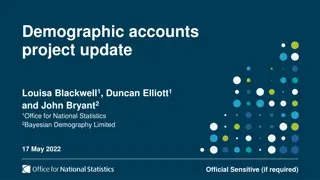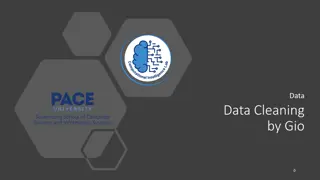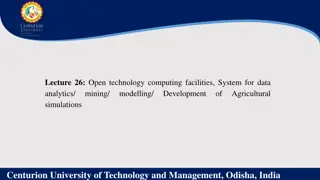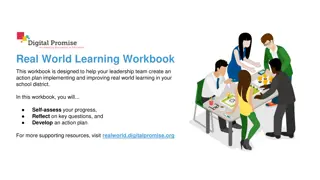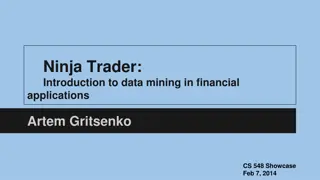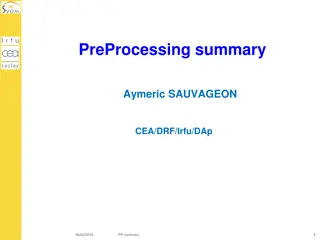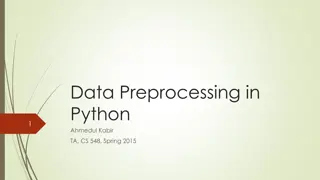Importance of Data Preprocessing in Real-World Data Analysis
Data preprocessing is essential due to the inherent dirtiness of real-world data, such as incompleteness, noisiness, and inconsistencies. This process involves cleaning, integration, transformation, and reduction of data to ensure quality for effective data mining and decision-making. The need arises from various sources like faulty collection instruments, human errors, or inconsistent data sources, emphasizing the significance of quality data in obtaining reliable insights.
Download Presentation

Please find below an Image/Link to download the presentation.
The content on the website is provided AS IS for your information and personal use only. It may not be sold, licensed, or shared on other websites without obtaining consent from the author.If you encounter any issues during the download, it is possible that the publisher has removed the file from their server.
You are allowed to download the files provided on this website for personal or commercial use, subject to the condition that they are used lawfully. All files are the property of their respective owners.
The content on the website is provided AS IS for your information and personal use only. It may not be sold, licensed, or shared on other websites without obtaining consent from the author.
E N D
Presentation Transcript
Knowledge Data Discovery TOPIC 4 - Data Preprocessing Antoni Wibowo
COURSE OUTLINE 1. WHY PREPROCESS THE DATA? 2. DATA CLEANING 3. DATA INTEGRATION AND TRANSFORMATION 4. DATA REDUCTION
Note: This slides are based on the additional material provided with the textbook that we use: J. Han, M. Kamber and J. Pei, Data Mining: Concepts and Techniques and P. Tan, M. Steinbach, and V. Kumar "Introduction to Data Mining .
Why Data Preprocessing? Data in the real world is dirty Incomplete: lacking attribute e.g., occupation= Noisy: containing errors or outliers e.g., Salary= -10 Inconsistent: containing discrepancies in codes or names e.g., Age= 42 Birthday= 03/07/1997 e.g., Was rating 1,2,3 , now rating A, B, C e.g., discrepancy between duplicate records October 9, 2024 Data Preprocessing 4
Why is Data Dirty? Incomplete data may come from Not applicable data value when collected Different considerations between the time when the data was collected and when it is analyzed*) Human/hardware/software problems Noisy data (incorrect values) may come from Faulty data collection instruments Human or computer error at data entry Errors in data transmission Inconsistent data may come from Different data sources Functional dependency violation (e.g., modify some linked data) **) Duplicate records also need data cleaning October 9, 2024 Data Preprocessing 5
Why is Data Preprocessing Important? No quality data, no quality mining results! Quality decisions must be based on quality data e.g., duplicate or missing data may cause incorrect or even misleading statistics. Data warehouse needs consistent integration of quality data Data extraction, cleaning, and transformation comprises the majority of the work of building a data warehouse (up to 90%) October 9, 2024 Data Preprocessing 6
Multi-Dimensional Measure of Data Quality A well-accepted multidimensional view: Accuracy Completeness Consistency Timeliness Believability Non-redudancy Relevance Interpretability Accessibility October 9, 2024 Data Preprocessing 7
Major Tasks in Data Preprocessing Data cleaning Fill in missing values, smooth noisy data, identify or remove outliers, and resolve inconsistencies Data integration Integration of multiple databases, data cubes, or files Data transformation Normalization and aggregation Data reduction Obtains reduced representation in volume but produces the same or similar analytical results Data discretization Part of data reduction but with particular importance, especially for numerical data October 9, 2024 Data Preprocessing 8
Forms of Data Preprocessing Data Integration Data Cleaning Data Transformation Data Reduction October 9, 2024 Data Preprocessing 9
Data Cleaning Importance Data cleaning is one of the three biggest problems in data warehousing Ralph Kimball Data cleaning is the number one problem in data warehousing DCI survey Data cleaning tasks Fill in missing values Identify outliers and smooth out noisy data Correct inconsistent data Resolve redundancy caused by data integration October 9, 2024 Data Preprocessing 10
Missing Data Data is not always available E.g., many tuples have no recorded value for several attributes, such as customer income in sales data Missing data may be due to Equipment malfunction Inconsistent with other recorded data and thus deleted Data not entered due to misunderstanding Certain data may not be considered important at the time of entry Missing data may need to be inferred *) October 9, 2024 Data Preprocessing 11
How to Handle Missing Data? Ignore the tuple: usually done when class label is missing (assuming the tasks in classification not effective when the percentage of missing values per attribute varies considerably. Fill in the missing value manually: tedious + infeasible? Fill in it automatically with A global constant : e.g., Unknown , a new class?! The attribute mean The attribute mean for all samples belonging to the same class: smarter The most probable value: inference-based such as bayesian formula or decision tree *) October 9, 2024 Data Preprocessing 12
Noisy Data Noise: random error or variance in a measured variable Incorrect attribute values may due to Faulty data collection instruments Data entry problems Data transmission problems Technology limitation *) Inconsistency in naming convention Other data problems which requires data cleaning Duplicate records Incomplete data Inconsistent data October 9, 2024 Data Preprocessing 13
How to Handle Noisy Data? Binning First sort data and partition into (equal-frequency) bins Then one can smooth by bin means, smooth by bin median, smooth by bin boundaries, etc. Regression Smooth by fitting the data into regression functions Clustering Detect and remove outliers Combined computer and human inspection Detect suspicious values and check by human (e.G., Deal with possible outliers) October 9, 2024 Data Preprocessing 14
Simple Discretization Methods: Binning Equal-width (distance) partitioning Divides the range into N intervals of equal size: uniform grid if A and B are the lowest and highest values of the attribute, the width of intervals will be: W = (B A)/N. The most straightforward, but outliers may dominate presentation Skewed data is not handled well Equal-depth (frequency) partitioning Divides the range into N intervals, each containing approximately same number of samples Good data scaling Managing categorical attributes can be tricky October 9, 2024 Data Preprocessing 15
Binning Methods for Data Smoothing Sorted data for price (in dollars): 4, 8, 9, 15, 21, 21, 24, 25, 26, 28, 29, 34 * Partition into equal-frequency (equi-depth) bins: - Bin 1: 4, 8, 9, 15 - Bin 2: 21, 21, 24, 25 - Bin 3: 26, 28, 29, 34 * Smoothing by bin means: - Bin 1: 9, 9, 9, 9 - Bin 2: 23, 23, 23, 23 - Bin 3: 29, 29, 29, 29 * Smoothing by bin boundaries: - Bin 1: 4, 4, 4, 15 - Bin 2: 21, 21, 25, 25 - Bin 3: 26, 26, 26, 34 October 9, 2024 Data Preprocessing 16
Regression y Y1 y = x + 1 Y1 x X1 October 9, 2024 Data Preprocessing 17
Cluster Analysis October 9, 2024 Data Preprocessing 18
Data Cleaning as a Process Data discrepancy detection Use metadata (e.g., domain, range, dependency, distribution) Check field overloading Check uniqueness rule, consecutive rule and null rule Use commercial tools Data scrubbing: use simple domain knowledge (e.g., postal code, spell-check) to detect errors and make corrections Data auditing: by analyzing data to discover rules and relationship to detect violators (e.g., correlation and clustering to find outliers) Data migration and integration Data migration tools: allow transformations to be specified *) ETL (Extraction/Transformation/Loading) tools: allow users to specify transformations through a graphical user interface Integration of the two processes **) Iterative and interactive (e.g., Potter s Wheels) October 9, 2024 Data Preprocessing 19
ETL on Pentaho Data Integration (Spoon) 10/9/2024 Data Preprocessing 20
Data Integration Data integration: Combines data from multiple sources into a coherent store Schema integration: e.g., A.cust-id B.cust-# Integrate metadata from different sources *) Entity identification problem: Identify real world entities from multiple data sources, e.g., Bill Clinton = William Clinton Detecting and resolving data value conflicts For the same real world entity, attribute values from different sources are different Possible reasons: different representations, different scales, e.g., metric vs. British units October 9, 2024 Data Preprocessing 21
Handling Redundancy in Data Integration Redundant data occur often when integration of multiple databases Object identification: The same attribute or object may have different names in different databases *) Derivable data:One attribute may be a derived attribute in another table, e.g., annual revenue Redundant attributes may be able to be detected by correlation analysis Careful integration of the data from multiple sources may help reduce/avoid redundancies and inconsistencies and improve mining speed and quality October 9, 2024 Data Preprocessing 22
Correlation Analysis (Numerical Data) Correlation coefficient (also called Pearson s product moment coefficient) ( )( ) ( ) A ( A ) 1 B B AB n A B = = r , A B ( ) 1 n n A B A B where n is the number of tuples, and are the respective means of A and B, A and B are the respective standard deviation of A and B, and (AB) is the sum of the AB cross-product. A B If rA,B> 0, A and B are positively correlated (A s values increase as B s). The higher, the stronger correlation. rA,B = 0: independent; rA,B < 0: negatively correlated October 9, 2024 Data Mining: Concepts and Techniques 23
Correlation Analysis (Categorical Data) 2 (chi-square) test 2 Observed ( ) Expected = 2 Expected The larger the 2 value, the more likely the variables are related The cells that contribute the most to the 2 value are those whose actual count is very different from the expected count Correlation does not imply causality # of hospitals and # of car-theft in a city are correlated Both are causally linked to the third variable: population October 9, 2024 Data Preprocessing 24
Chi-Square Calculation: An Example Preferred Reading Like science fiction Male 250(90) Female 200(360) Sum (row) 450 Not like science fiction 50(210) 1000(840) 1050 Sum(col.) 300 1200 1500 2 (chi-square) calculation (numbers in parenthesis are expected counts calculated based on the data distribution in the two categories) 2 2 2 2 ( 250 90 ) 50 ( 210 ) ( 200 360 ) 1000 ( 840 ) = + + + = 2 507 93 . 90 210 360 840 It shows that like_science_fiction and play_chess are correlated in the group October 9, 2024 Data Preprocessing 25
Data Transformation Smoothing: remove noise from data Aggregation: summarization, data cube construction Generalization: concept hierarchy climbing *) Normalization: scaled to fall within a small, specified range min-max normalization z-score normalization normalization by decimal scaling Attribute/feature construction New attributes constructed from the given ones October 9, 2024 Data Preprocessing 26
Data Transformation: Normalization Min-max normalization: to [new_minA, new_maxA] min v v ( ' A = + _ _ ) _ new max new min new min A A A max min A A Ex. Let income range $12,000 to $98,000 normalized to [0.0, 1.0]. Then $73,000 is mapped to 000 , 12 000 , 98 73 , 600 12 , 000 ) 0 + = 0 . 1 ( 0 . 0 716 Z-score normalization ( : mean, : standard deviation): v v A = ' A 73 , 600 54 , 000 . 1 = Ex. Let = 54,000, = 16,000. Then 225 16 , 000 Normalization by decimal scaling v v 10 '= Where j is the smallest integer such that Max(| |) < 1 j October 9, 2024 Data Preprocessing 27
Data Reduction Strategies Why data reduction? A database/data warehouse may store terabytes of data Complex data analysis/mining may take a very long time to run on the complete data set Data reduction Obtain a reduced representation of the data set that is much smaller in volume but yet produce the same (or almost the same) analytical results Data reduction strategies Data cube aggregation: Dimensionality reduction e.g., remove unimportant attributes Data Compression Numerosity reduction e.g., fit data into models Discretization and concept hierarchy generation October 9, 2024 Data Preprocessing 28
Data Cube Aggregation The lowest level of a data cube (base cuboid) The aggregated data for an individual entity of interest E.g., a customer in a phone calling data warehouse Multiple levels of aggregation in data cubes Further reduce the size of data to deal with Reference appropriate levels Use the smallest representation which is enough to solve the task Queries regarding aggregated information should be answered using data cube, when possible October 9, 2024 Data Preprocessing 29
Data Cube Aggregation (Example) The data consist of the AllElectronics sales per quarter, for the years 2002 to 2004, we only interested in the annual sales (total per year), rather than the total per quarter. Thus the data can be aggregated so that the resulting data summarize the total sales per year instead of per quarter 10/9/2024 Data Preprocessing 30
Attribute Subset Selection Feature selection (i.e., attribute subset selection): Select a minimum set of features such that the probability distribution of different classes given the values for those features is as close as possible to the original distribution given the values of all features reduce # of patterns in the patterns, easier to understand Heuristic methods (due to exponential # of choices): Step-wise forward selection Step-wise backward elimination Combining forward selection and backward elimination Decision-tree induction October 9, 2024 Data Preprocessing 31
Attribute Subset Selection Forward selection Backward elimination 10/9/2024 Data Preprocessing 32
Example of Decision Tree Induction Initial attribute set: {A1, A2, A3, A4, A5, A6} A4 ? A6? A1? Class 2 Class 2 Class 1 Class 1 > Reduced attribute set: {A1, A4, A6} October 9, 2024 Data Preprocessing 33
Data Compression String compression There are extensive theories and well-tuned algorithms Typically lossless Audio/video compression Typically lossy compression, with progressive refinement Sometimes small fragments of signal can be reconstructed without reconstructing the whole (audio streaming, for example) Time sequence is not audio Typically short and vary slowly with time October 9, 2024 Data Preprocessing 34
Dimensionality Reduction: Principal Component Analysis (PCA) Given N data vectors from n-dimensions, find k n orthogonal vectors (principal components) that can be best used to represent data Steps Normalize input data: Each attribute falls within the same range Compute k orthonormal (unit) vectors, i.e., principal components Each input data (vector) is a linear combination of the k principal component vectors The principal components are sorted in order of decreasing significance or strength Since the components are sorted, the size of the data can be reduced by eliminating the weak components, i.e., those with low variance. (i.e., using the strongest principal components, it is possible to reconstruct a good approximation of the original data Works for numeric data only Used when the number of dimensions is large October 9, 2024 Data Preprocessing 35
Principal Component Analysis X2 PC1 PC2 X1 October 9, 2024 Data Mining: Concepts and Techniques 36
Numerosity Reduction Reduce data volume by choosing alternative, smaller forms of data representation Parametric methods Assume the data fits some model, estimate model parameters, store only the parameters, and discard the data (except possible outliers) Example: Log-linear models obtain value at a point in n-D space as the product on appropriate marginal subspaces Non-parametric methods Do not assume models Major families: histograms, clustering, sampling October 9, 2024 Data Preprocessing 37
Regression Analysis & Log-Linear Models Linear regression: Y = w X + b Two regression coefficients, w and b, specify the line and are to be estimated by using the data at hand Using the least squares criterion to the known values of Y1, Y2, , X1, X2, . Multiple regression: Y = b0 + b1 X1 + b2 X2. Many nonlinear functions can be transformed into the above Log-linear models: The multi-way table of joint probabilities is approximated by a product of lower-order tables Probability: p(a, b, c, d) = ab ac ad bcd
Data Reduction Method: Histograms Divide data into buckets and store average (sum) for each bucket Partitioning rules: Equal-width: equal bucket range Equal-frequency (or equal-depth) V-optimal: with the least histogram variance (weighted sum of the original values that each bucket represents) MaxDiff: set bucket boundary between each pair for pairs have the 1 largest differences October 9, 2024 Data Mining: Concepts and Techniques 39
Data Reduction Method: Clustering Partition data set into clusters based on similarity, and store cluster representation (e.g., centroid and diameter) only Can be very effective if data is clustered but not if data is smeared Can have hierarchical clustering and be stored in multi-dimensional index tree structures There are many choices of clustering definitions and clustering algorithms October 9, 2024 Data Preprocessing 40
Data Reduction Method: Sampling Sampling: obtaining a small sample s to represent the whole data set N Allow a mining algorithm to run in complexity that is potentially sub- linear to the size of the data Choose a representative subset of the data Simple random sampling may have very poor performance in the presence of skew Develop adaptive sampling methods Stratified sampling: Approximate the percentage of each class (or subpopulation of interest) in the overall database Used in conjunction with skewed data Note: Sampling may not reduce database I/Os (page at a time) October 9, 2024 Data Preprocessing 41
Sampling: with or without Replacement Raw Data October 9, 2024 Data Preprocessing 42
Sampling: Cluster or Stratified Sampling Cluster/Stratified Sample Raw Data October 9, 2024 Data Preprocessing 43
Summary Raw data are dirty usually due to incomplete, noisy and inconsistent. Data Preprocessing is important to ensure the quality mining results. Data cleaning is one of the three biggest problems in data warehousing. Data integration combines data from multiple sources into a coherent store. Data reduction reduces representation of the data set that is much smaller in volume but yet produce the same (or almost the same) analytical results. 44 October 9, 2024 Introduction
References 1. Han, J., Kamber, M., & Pei, Y. (2006). Data Mining: Concepts and Technique . Edisi 3. Morgan Kaufman. San Francisco 2. Tan, P.N., Steinbach, M., & Kumar, V. (2006). Introduction to Data Mining . Addison-Wesley. Michigan 3. Witten, I. H., & Frank, E. (2005). Data Mining : Practical Machine Learning Tools and Techniques . Second edition. Morgan Kaufmann. San Francisco 10/9/2024 Introduction 45
Thank You Thank You




